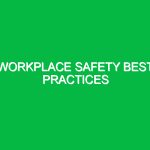In today’s industrial landscape, the significance of Safety in High-Pressure Environments cannot be overstated. Whether it’s in oil and gas extraction, chemical manufacturing, or even in certain medical contexts, high-pressure situations present unique challenges that demand strict adherence to health, safety, and environmental (HSE) standards. These environments can pose serious risks to workers and equipment alike, making it essential to understand the potential hazards and implement effective safety measures. This article delves into the intricacies of safety in high-pressure environments, exploring risks, precautions, regulations, and best practices that can safeguard both personnel and operations.
Understanding High-Pressure Environments
High-pressure environments refer to settings where the pressure exceeds normal atmospheric levels, typically above 15 psi (pounds per square inch). These conditions are prevalent in various industries, including:
- Oil and Gas: Extraction and refining processes often require handling gases and liquids under extreme pressure.
- Chemical Manufacturing: Many chemical reactions occur at elevated pressures to enhance reaction rates and yield.
- Medical Applications: Hyperbaric oxygen therapy, which treats various medical conditions, operates at high pressures.
Given these applications, the relevance of safety in high-pressure environments becomes apparent. A single oversight can lead to catastrophic failures, resulting in injuries, fatalities, or extensive damage to property and the environment.
Identifying Hazards and Risks
Understanding the potential hazards associated with high-pressure environments is vital for effective safety management. Here are some common risks:
1. Pressure Release
Sudden release of high-pressure gas or liquid can lead to explosive decompression, resulting in flying debris and injuries. For instance, in a gas processing plant, a failure in a pressure relief valve can cause a dangerous buildup of pressure, leading to an uncontrollable release.
2. Equipment Failures
High-pressure systems often involve complex machinery that can fail under stress. This can occur due to fatigue, corrosion, or improper maintenance. A real-world example is the Deepwater Horizon oil spill, where equipment failure under high pressure resulted in one of the largest environmental disasters in history.
3. Chemical Exposure
In environments where chemicals are stored or processed under high pressure, leaks can expose workers to toxic substances. For example, ammonia used in refrigeration can be hazardous if leaked, causing respiratory issues or chemical burns.
4. Human Error
Errors in judgment, such as improper equipment handling or failure to follow protocols, can lead to dangerous situations. A case study from the chemical industry revealed that human error was a significant contributing factor in several high-pressure accidents, underscoring the need for training and awareness.
5. Environmental Impact
High-pressure incidents can lead to spills and leaks, posing risks not just to human health but also to the environment. Contaminated water supplies and damage to ecosystems can result from a single failure in a high-pressure system.
Implementing Safety Precautions
To mitigate risks associated with high-pressure environments, organizations must adopt comprehensive safety precautions. Here are some best practices:
1. Regular Maintenance and Inspections
Routine checks of equipment and systems are essential. This includes inspecting pressure vessels, valves, and piping for signs of wear and tear. A well-documented maintenance schedule can help identify issues before they escalate into severe problems.
2. Use of Safety Equipment
Personal protective equipment (PPE) is crucial in high-pressure environments. Workers should be equipped with helmets, face shields, gloves, and protective clothing. For example, in a chemical plant, specialized suits can protect against exposure to harmful substances.
3. Training and Certification
Employees must receive thorough training on high-pressure operations, including emergency response protocols. Continuous education programs can keep staff updated on the latest safety practices. For instance, the American Society of Safety Professionals offers certifications that help workers stay informed about hazards and safety measures.
4. Establishing Safety Protocols
Developing clear safety protocols tailored to specific operations is vital. These protocols should outline procedures for handling emergencies, conducting safe equipment operation, and reporting incidents. For example, creating a checklist for pressure testing can ensure that all safety measures are observed before commencing work.
5. Emergency Preparedness
Every facility should have an emergency response plan that includes evacuation routes, first-aid stations, and communication protocols. Conducting regular drills can prepare employees for real-life scenarios. A notable case is the successful evacuation during a high-pressure incident at a petrochemical plant, which saved numerous lives due to pre-planned emergency procedures.
Regulations and Standards
Several regulations govern safety in high-pressure environments. These include:
1. OSHA Standards
The Occupational Safety and Health Administration (OSHA) sets forth guidelines for workplace safety that apply to high-pressure operations. These regulations cover aspects such as equipment maintenance, employee training, and emergency preparedness.
2. API Standards
The American Petroleum Institute (API) provides industry-specific guidelines, particularly for the oil and gas sector. Their standards address the design, construction, and maintenance of high-pressure systems, ensuring safer operations.
3. ASME Codes
The American Society of Mechanical Engineers (ASME) publishes codes that focus on pressure vessels and piping systems. Adhering to these codes is essential for ensuring the structural integrity and safety of high-pressure equipment.
4. Local Regulations
In addition to national standards, local regulations may apply, depending on the jurisdiction. Businesses must stay informed about these laws to maintain compliance and ensure the safety of their operations.
Conclusion
Safety in high-pressure environments is a multifaceted domain that requires ongoing attention and proactive management. By understanding the associated hazards and implementing robust safety measures, organizations can significantly reduce the risk of accidents and protect their workforce. It is vital to foster a culture of safety, where employees are encouraged to prioritize safety practices and feel empowered to report potential risks. In the end, a commitment to safety not only protects lives but also enhances operational efficiency and environmental stewardship.


